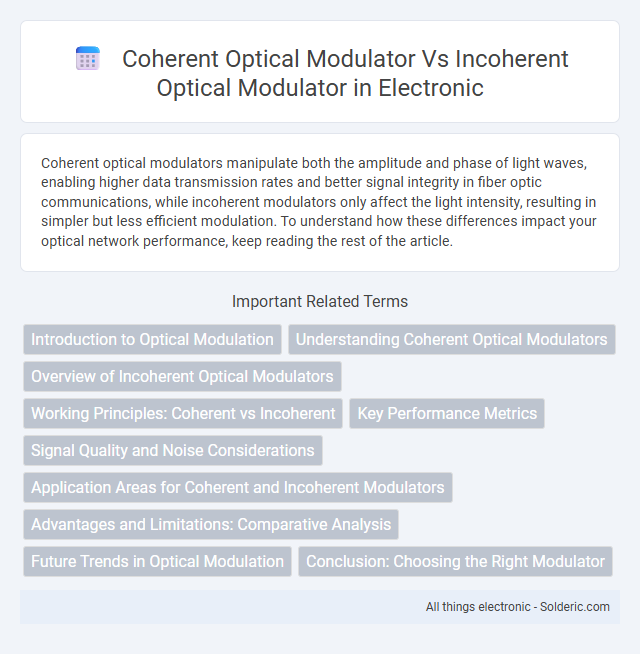Coherent optical modulators manipulate both the amplitude and phase of light waves, enabling higher data transmission rates and better signal integrity in fiber optic communications, while incoherent modulators only affect the light intensity, resulting in simpler but less efficient modulation. To understand how these differences impact your optical network performance, keep reading the rest of the article.
Comparison Table
| Feature | Coherent Optical Modulator | Incoherent Optical Modulator |
|---|---|---|
| Signal Type | Phase and amplitude modulated signals | Amplitude modulated signals only |
| Light Source | Laser-based coherent light | LED or broadband incoherent light |
| Modulation Method | Uses phase, frequency, and amplitude modulation | Uses intensity modulation only |
| Sensitivity | High sensitivity; supports advanced detection | Lower sensitivity; simpler detection schemes |
| Data Transmission | High data rates; supports coherent communication | Lower data rates; intensity-modulated only |
| Complexity | High complexity; requires phase control and stabilization | Lower complexity; simpler design |
| Applications | Long-haul fiber optics, high-speed telecom | Short-range communication, simple optical links |
| Cost | Higher due to precision components | Lower cost, easier fabrication |
Introduction to Optical Modulation
Coherent optical modulators manipulate the phase, amplitude, or polarization of a light wave, enabling high-capacity and long-distance optical communication through precise signal encoding. Incoherent optical modulators, by contrast, vary only the light intensity without preserving phase information, making them simpler but less efficient for advanced data transmission. Your choice between these modulators impacts the complexity, bandwidth, and noise tolerance of optical communication systems.
Understanding Coherent Optical Modulators
Coherent optical modulators enable precise control of both the amplitude and phase of light waves, essential for advanced communication systems requiring high spectral efficiency and data rates. Unlike incoherent modulators that only vary intensity, coherent modulators leverage phase modulation techniques like QPSK and QAM to maximize signal fidelity and transmission capacity. Understanding coherent optical modulators helps optimize your network's performance by improving signal integrity and enabling sophisticated multiplexing strategies.
Overview of Incoherent Optical Modulators
Incoherent optical modulators operate by directly modulating the intensity of light without preserving the phase information, making them simpler and more cost-effective for applications like short-reach communication and optical switching. Unlike coherent optical modulators, which control both amplitude and phase to enable advanced multiplexing and higher data rates, incoherent modulators primarily support basic on-off keying and amplitude modulation schemes. Your choice of an incoherent optical modulator is ideal for systems where phase sensitivity is unnecessary, emphasizing ease of integration and lower complexity.
Working Principles: Coherent vs Incoherent
Coherent optical modulators manipulate the phase, amplitude, and polarization of a light wave using interference between a reference beam and the modulated signal, enabling precise phase encoding and higher spectral efficiency. Incoherent optical modulators alter only the intensity or amplitude of the light signal without preserving phase information, typically through absorption or electro-optic effects. The coherent approach supports advanced modulation formats like QAM and PSK, while incoherent modulation is limited to simpler on-off keying and intensity modulation techniques.
Key Performance Metrics
Coherent optical modulators provide high spectral efficiency and superior sensitivity by preserving both amplitude and phase information of the optical signal, resulting in advanced modulation formats such as QPSK and QAM. In contrast, incoherent optical modulators primarily modulate intensity, leading to simpler designs but limited bandwidth and lower signal-to-noise ratios. Key performance metrics for coherent modulators include phase noise, modulation bandwidth, and linearity, while incoherent modulators are evaluated mainly on extinction ratio, insertion loss, and power consumption.
Signal Quality and Noise Considerations
Coherent optical modulators offer superior signal quality through precise phase and amplitude control, enabling higher spectral efficiency and improved sensitivity in optical communication systems. Incoherent optical modulators generally exhibit higher noise levels due to their reliance on intensity modulation without phase information, resulting in poorer signal-to-noise ratio (SNR) performance. The enhanced noise resilience and lower bit error rates in coherent modulators make them the preferred choice for long-haul and high-capacity data transmission applications.
Application Areas for Coherent and Incoherent Modulators
Coherent optical modulators are primarily utilized in high-capacity telecommunications, coherent optical sensing, and advanced fiber-optic communication systems due to their ability to manipulate both amplitude and phase of light signals. Incoherent optical modulators find extensive use in simpler, short-reach applications such as LED-based optical interconnects, optical switching, and basic signal modulation where phase information is not required. The choice between coherent and incoherent modulators depends on the complexity of the application, with coherent modulators favored for high-speed, long-distance data transmission and incoherent modulators suited for cost-effective, short-distance optical systems.
Advantages and Limitations: Comparative Analysis
Coherent optical modulators offer higher sensitivity and improved signal-to-noise ratio due to their ability to preserve phase information, enabling advanced modulation formats like QAM for enhanced data capacity. Incoherent optical modulators, while simpler and more robust against phase noise, usually suffer from lower spectral efficiency and limited modulation complexity. The trade-off involves coherent modulators requiring more complex and expensive receivers, whereas incoherent modulators benefit from cost-effective implementation but at the expense of transmission performance and reach.
Future Trends in Optical Modulation
Future trends in optical modulation emphasize the growing adoption of coherent optical modulators due to their superior spectral efficiency and resilience to signal degradation, which are essential for high-capacity, long-distance fiber optic communication systems. Incoherent optical modulators, while simpler and cost-effective, are gradually being replaced as networks demand more precise phase and amplitude control achievable only through coherent techniques. Your optical communication infrastructure can benefit from integrating coherent modulators to meet evolving bandwidth requirements and support advanced modulation formats like QAM and OFDM.
Conclusion: Choosing the Right Modulator
Coherent optical modulators offer high spectral efficiency and precise phase control, making them ideal for long-haul and high-capacity communication systems. Incoherent optical modulators, while simpler and cost-effective, are better suited for short-reach applications due to their lower complexity and reduced sensitivity to phase noise. Your choice depends on balancing system requirements such as bandwidth, distance, and budget constraints.
Coherent optical modulator vs incoherent optical modulator Infographic

 solderic.com
solderic.com